Tomato seed harvest #2 If you want to keep the tomato useful, just slice the skin around the equator and give a little squeeze...voila! Out come the best seeds which i collect in a little plastic strainer that i rinse a bit of the tomato guts off the seeds. This is one of the rarest of all....a green grape. Looks like what fills a diaper after feeding broccoli to baby. And splits and gets as mushy too - really fast once it ripens. The trick is to pick it at perfect time. Prolly the most amazing flavor you will ever find.
Tomato seed harvest #1 Pick some of your favourite tomatoes, take any normal paper and write in pencil the name of the tomato (or make one up), a description of the fruit (size, colour, shape, flavour), and something about the plant size...very important! And if it is determinant (short lived) or indeterminate( will produce till freezing).
I just LOVE these little beauties. They take a while, and use up a lot of space, but once producing make up to 15 of these weird alien flying saucers. So mild and tender. Wave them by an aquarium and they will taste like seafood!
Feast of Fields event on Sunday went very smooth. FarmFolk CityFolk
www.farmfolkcity had about 800 people getting stuffed and liquored up. Proceeds went towards a good cause that touched my heartstrings enough to get my ass out of my gardens to come help. This group helps new farmers and does crazy anti Monsanto stuff like collect natural seeds!
Heirloom Tomatos These little beauties are priceless! And that is one reason toms like these are not found in restaurants and stores. But if monetary values were necessary, here is the math:
Many heirlooms yield only about 10% of that of a common red variety, natural or gene tailored. So a $2.50/lb store price becomes $25/lb.
Costs to grow on a small organic basis easily twice that of Monsanto Blessed industrial farming. Now our tomato is $50/lb. !!!!
This rare heirloom plant produces between one and three fruit in a season.This is the first, and we will just have to wait to see if a perfect scarlet heart appears ....but we all know "waiting is poor time management" so stay tuned for my next blog entry. I will explain why you dont see these in stores and restaurants.
Controlling Tomato Leaf Spot Diseases
Daniels short version:
Planning IS Prevention. All garden plant materials get buried under the deep pile of leaves added in the fall. Everything goes back into the soil except the fruit harvested. Irrigate in such a way water is low on the plant and will not splash soil born bacteria. Tall staking of the plant allows for bottom leaves to go ahead and die...lots more where those came from.
The long version stole from someone.....
Nothing is better than a home-grown, garden tomato, but growing tomatoes does have its pitfalls, including disease problems. Tomatoes are subject to many diseases, both leaf spots and wilts. Tomatoes are attacked by both fungi and bacterial diseases that affect the leaves, petioles and stems, and cause blemishes on the fruits. Foliage diseases weaken infected plants by killing the leaves, which are the plant’s factories for carbohydrate and energy production. Loss of foliage due to disease, causes the tomato plant to be less productive or vigorous. If foliage diseases are not controlled, they can lead to death of the plant. If too many leaves are killed then tomato production and quality will be affected. Severe foliage loss can lead to sunscald on developing tomatoes, which are suddenly exposed to more intense sunlight. Common diseases of tomato include septoria leaf spot, early blight, bacterial speck and bacterial spot. All of these diseases overwinter in the vegetable garden on infected plant debris. The spores are spread during the growing season by wind, water and human activity.
Septoria leaf spot begins as tiny black dots on the leaves, enlarging to small circular spots with a dark margin and gray center. Infected leaves turn yellow and die. Elongated lesions develop on stems and petioles.
Early blight appears as irregular, dark brown areas on the leaves with concentric, black rings developing in a target-like pattern as the spots enlarge. Dark brown, sunken lesions form on stems and petioles. These symptoms appear about 10 days after infection. Early blight occurs in midsummer during warm, humid periods and can spread very rapidly.
Bacterial speck and spot are both spread by infected plant debris during periods of humid, wet weather. Bacterial speck appears as tiny, pinhead sized, raised black specks on tomato leaves and fruits.
Bacterial spot is very similar to bacterial speck, but the leaf and fruit spots are slightly larger. On tomato fruits, bacterial spot results in slightly raised, brown, scabby lesions.
Sanitation is very important for reducing disease pressure in your garden each year. Remove all plant debris that is left in the garden from last season before tilling and planting. Establish a 3-4 year rotation schedule in your garden, by moving those plants most affected by disease to containers or new plots of ground. Or choose not to grow heavily affected plants for a few years to reduce populations of disease organisms in the soil.
One of the most common methods of tomato leaf infection is through rain splashing on bare soil. All of the diseases mentioned above overwinter on infected plant debris in the soil. During a rainstorm, water droplets hit the soil surface, splashing water and soil up onto the lowest tomato leaves. Prevent rain splash in your garden by covering the soil with mulch. Apply a 2-3 inch layer of mulch, using old leaves, clean straw, newspapers topped with wood chips, or any other coarse organic material. Mulch also helps suppresses weed growth, moderates soil temperature extremes and helps retain soil moisture. Staking is important as an early blight control program, since staking keeps foliage and fruit from contacting the soil surface.
Keep tomato leaves as dry as possible by applying water to the base of plants through soaker hoses, instead of using an overhead sprinkler, since water on the leaf
surface promotes germination of fungal spores and leaf infection.
Remove and discard heavily infected plants. Infections may be slowed by removing diseased leaves as they
appear.
For additional disease management, remove debris from tomato and pepper plants in the fall after harvest is completed or till debris into the soil.
What is blossom-end rot? How can I prevent it?
Daniel's short version:
Poopy Bum is from the plant itself not bringing calcium to the fruit. The plant may be getting a crazy ass amount of growth and not enough water, or weird weather phases. Just knock them off the plant like a retarded brother off his bike.
The Long Version (I stole from someone~~~~kudos to them anyways....)
Blossom-end rot is a disorder of tomato, squash, pepper, and all other fruiting vegetables. You notice that a dry sunken decay has developed on the blossom end (opposite the stem) of many fruit, especially the first fruit of the season. This is not a pest, parasite or disease process but is a physiological problem caused by a low level of calcium in the fruit itself.
Symptoms
BER, or blossom-end rot usually begins as a small "water-soaked looking" area at the blossom end of the fruit while still green. As the lesion develops, it enlarges, becomes sunken and turns tan to dark brown to black and leathery. In severe cases, it may completely cover the lower half of the fruit, becoming flat or concave, often resulting in complete destruction of the infected fruit.
Cause
Calcium is required in relatively large concentrations for normal cell growth. When a rapidly growing fruit is deprived of calcium, the tissues break down, leaving the characteristic lesion at the blossom end. Blossom-end rot develops when the fruit's demand for calcium exceeds the supply in the soil. This may result from low calcium levels in the soil, drought stress, excessive soil moisture, and/or fluctuations due to rain or overwatering . These conditions reduce the uptake and movement of calcium into the plant, or rapid, vegetative growth due to excessive nitrogen fertilization.
Management
Adequate preparation of the garden bed prior to planting is the key to preventing BER. Insure adequately draining soil in the bed by adding needed ammendments, maintain the soil pH around 6.5 - a pH out of this range limits the uptake of calcium. Lime (unless the soil is already alkaline), composted manures or bone meal will supply calcium but take time to work so must be applied prior to planting. Excess ammonial types of nitrogen in the soil can reduce calcium uptake as can a depleted level of phosphorus. After planting, avoid deep cultivation that can damage the plant roots, use mulch to help stabilize soil moisture levels and help avoid drought stress, avoid overwatering as plants generally need about one inch of moisture per week from rain or irrigation for proper growth and development.
Once the problem develops, quick fixes are difficult. Stabilize the moisture level as much as possible, but prevention is the key. Some recommend removing affected fruit from to reduce stress in the plant.
Rapid early growth accentuates the problem because it tends to increase the calcium requirement per unit of time.
Although a sudden lack of water is the principal cause of blossom end rot, excessive soil moistures early in the season may smother the root hairs and cause blossom end rot to occur during sudden hot weather. It may be more serious on the windward that on the leeward side of a field and more common on staked tomatoes than on bush types. Generally, blossom end rot is most common on the first fruits to turn red.
Management:
Since blossom end rot is so closely related to adequacy of water supply, an important control is to regulate the moisture supply in the soil. The land should allow good drainage during a wet period. If drought occurs, cultivation should be very shallow to reduce water loss and irrigation should be used. Hoeing or cultivating should be performed no closer than one foot from the plants to reduce root pruning.
In the greenhouse, transplants should not be grown too quickly nor should the plants be too old and subjected to severe hardening before transplanting. A steady growth rate as a seedling and as a field plant will discourage much of this problem.
If irrigation of any kind is available, it should be using during periods of hot, drying winds. Start to irrigate at the beginning of the dry spell. Mulching, which serves to maintain an even level of soil moisture, should be practiced where feasible. Mulch with black plastic or grass clippings to reduce moisture loss and to control weeds. Tomatoes and peppers planted unusually early, while the soil is still cold, are likely to have the first fruits affected by blossom end rot. Consequently, a delay in planting until soil
" The Contentment of Ko Hung" The contented man can be happy with what appears to be useless. He can find worthwhile occupation in the forests and mountains. He stays in a small cottage and associates with the simple. He would not exchange his worn clothes for the imperial robes, nor the load on his back for a four-horse carriage. He leaves the jade in the mountains and the pearls in the sea. Wherever he goes, whatever he does, he can he happy - he knows when to stop. He does not pick the brief-blossoming flower, he does not travel the dangerous road. To him, the ten thousand possessions are dust in the wind. He sings as he travels among the green mountains. He finds sheltering branches more comforting than red-gated mansions, the plow in his hands more rewarding than the prestige of titles and banners, fresh mountain water more satisfying than the feasts of the wealthy. He acts in true freedom. What can competition for honours mean to him? What attraction can anxiety and greed possibly hold'? Through simplicity he has Tao, and from Tao, everything. He sees the light in the "darkness", the clear in the "cloudy", the speed in the "slowness", the full in the "empty". The cook creating the meal with his own hands has as much in his eyes as a famous singer or high official. He has no profits to gain, no salary to lose, no applause, no criticism. When he looks up, it is not in envy. When he looks down, it is not in arrogance. Many look at him, but nobody sees him. Calm and detached, he is free from all danger, a dragon hidden among men.
Bondage at the Stake makes for big safe tomatoes. I use 8 ft end cuts trimmed from cedar fencing boards for tripod construction. I sharpen the bottom to make it easier to push each stake at least a foot away from the base of the plant. To secure the top i use a double wrap of haywire loosely connected, then scrunched by pliers to hold firm the three sticks together (easy to unwrap the wire for reuse each year). Tomato branches now have three vertical supports to tie with jute twine (decomposes easily). Now air can flow easily through plant, bottom leaves can be removed, and tomato fruit is supported far from ground.
As the plant gets taller the branches get tight nearing the top of the tripod and in the late fall act as a "toque" to stop frost falling inside the plant.
|
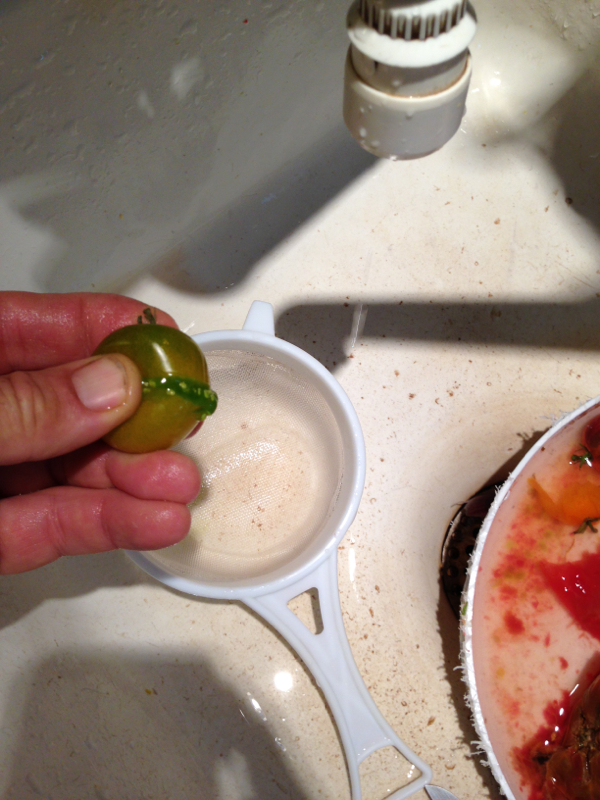
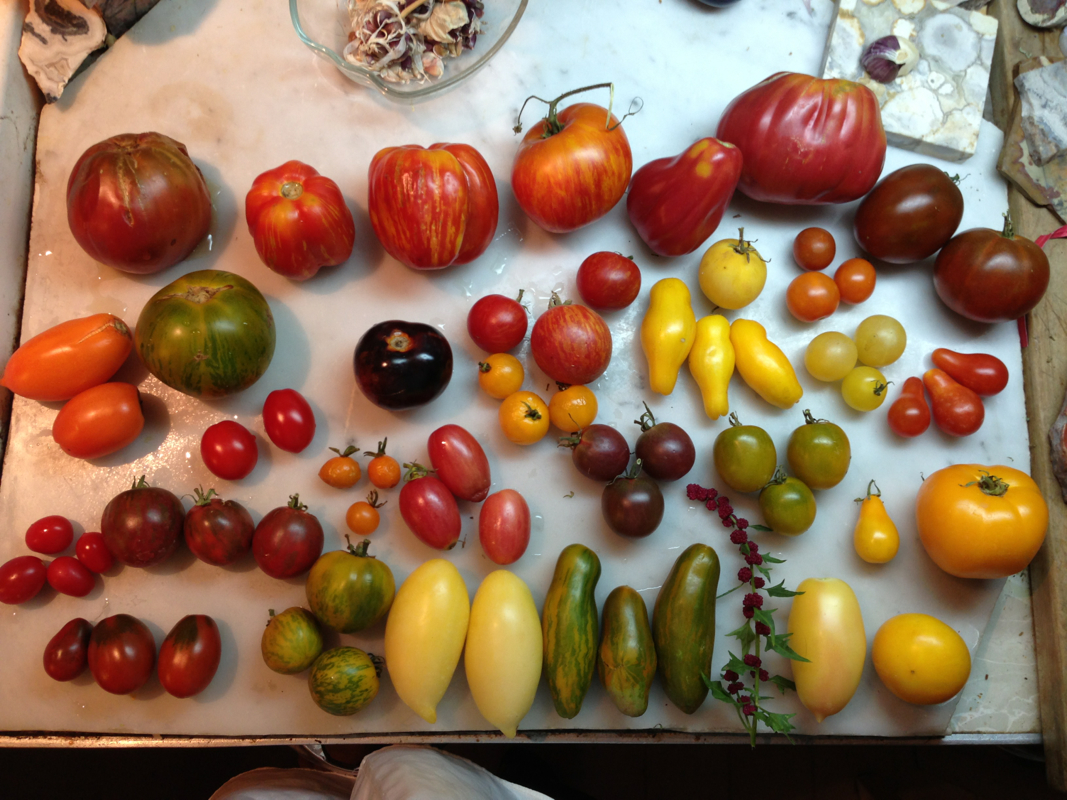
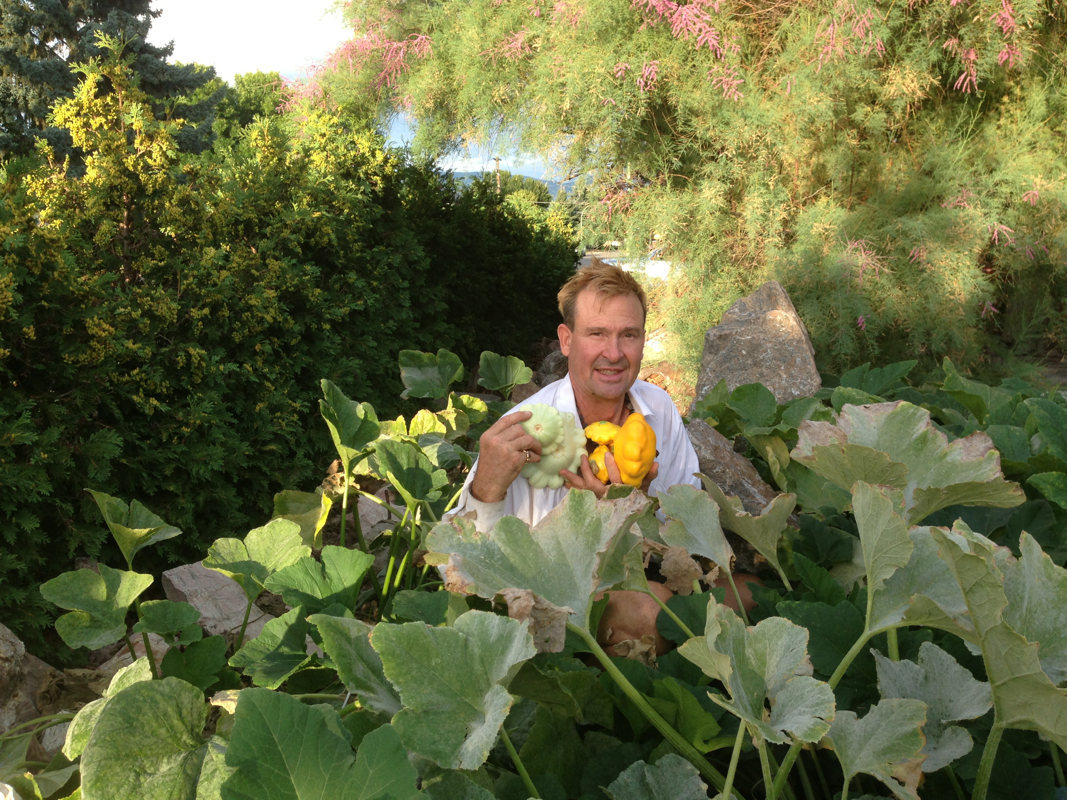


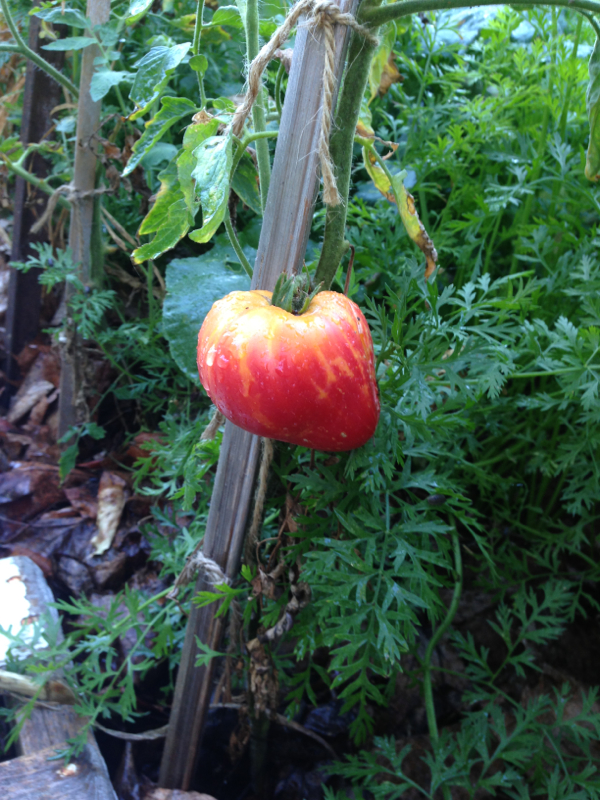
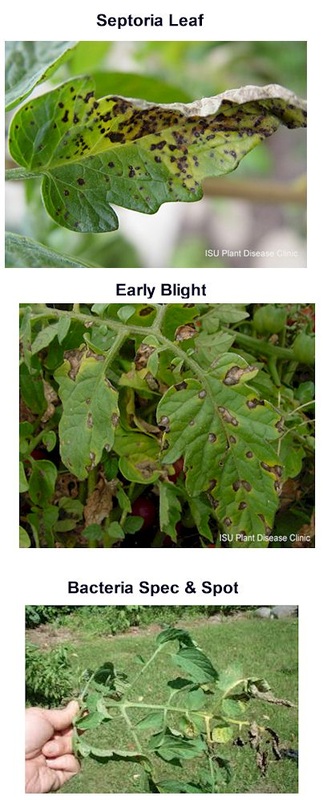

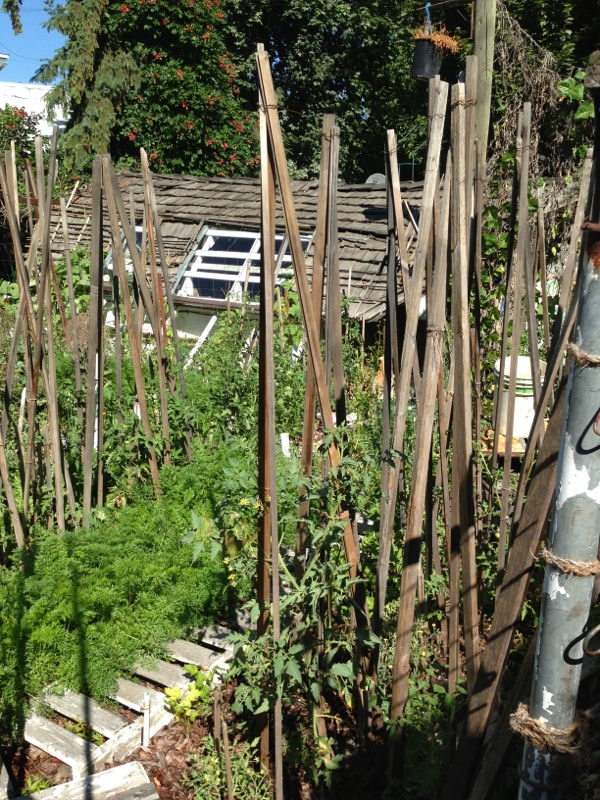
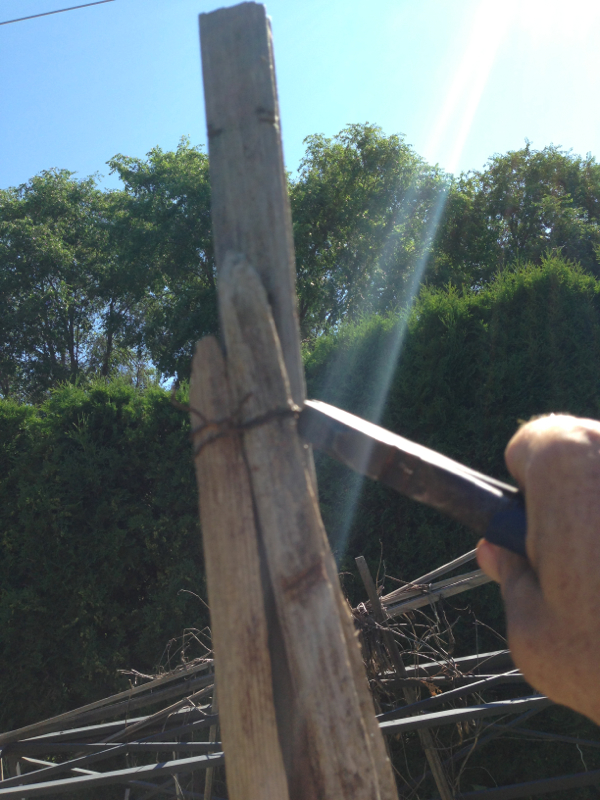
 RSS Feed
RSS Feed